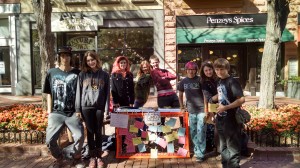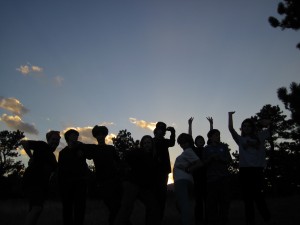
Genetically Modified Organisms (GMOs) have been in our food since the 1990s (Shireen 2013). They are approved by the FDA, are in a large majority of processed foods (FDA 2014), and are a billion dollar industry for such companies as Syngenta and Monsanto (Bart 2014). Still, many Americans fail to grasp a basic understanding of what they are. That is why Community Adventure Program (CAP) at New Vista High School in Boulder set out to lead an educational initiative to teach others about GMOs.
GMOs are plants that have the genetic material of other plants or animals inserted into their DNA. This gives them abilities that they would not naturally have. These abilities are generally one of two types. The first ability is for the plant to become herbicide resistant, so that when sprayed with weed killer the plant itself does not die. The second ability is to become a legal insecticide. If an insect lands on an insecticide GMO it will die immediately- protecting the crops (GMO OMG 2013). However, this calls into question: are GMOs dangerous? If insects are dying by landing on these plants, then what is protecting us? If our corn is sprayed with tons of herbicide, are we safe? The truth is, no one knows. Currently, eight crops are genetically modified: Alfalfa (first planting 2011), Canola (approx. 90% of U.S. crop), Corn (approx. 88% of U.S. crop), Cotton (approx. 90% of U.S. crop in 2011), Papaya (most of Hawaiian crop), Soy (approx. 94% of U.S.), Sugar Beets (approx. 95% of U.S. crop) and Zucchini and Yellow Summer Squash (approx. 25,000 acres) (Non GMO Project). No one is tracking these crops through the manufacturing process, therefore no one can tell which products at a store are genetically modified (Phillips 2008). That is why a labeling movement has sprung up all across the U.S. including in Colorado.

Labeling GMOs would make them trackable and therefore easier to study. With the ability to perform longitudinal studies on GMOs, we would be able to more fully understand the human health effects and environmental effects of GMOs. GMOs are linked to serious allergies in humans, environmental effects such as Colony Collapse Disorder (CCD) and declines in monarch butterfly populations. Labeling GMOs would also give people the right to choose how they want to eat based on their personal opinion. Prop 105 only requires the labeling of most processed foods, it does not bans GMOs. Furthermore, since Prop 105 is a statutory amendment, not a constitutional amendment, there can be flexibility and fine tuning through public hearings. More information about our food source can’t be a bad thing or else 60 countries in the European Union would not have mandatory labeling of genetically modified food (Right To Know Colorado).
Opponents of Proposition 105 argue that the fiscal responsibilities of introducing and maintaining GMO labeling may be enough to vote “no” on the proposition. Labeling GMOs may result in higher prices for food at the local grocer, as farmers, manufacturers, and distributors would be required to comply with the changing regulations (No on 105). The proposition could put Colorado food producers who ship to other states at a disadvantage because of label. Consumers who choose not to consume GMOs can look for the existing label, “Non-GMO Project Verified.” Proposition 105 would take $130,000 dollars from the state general fund annually in order to perform inspections. The federal government feels that current labeling standards are reliable and informative enough to continue without change (Colorado State Ballot and Blue Book 2014).
Is the proposition a step in the right direction or a step backwards for Colorado? That is for you to decide and we hope you will vote in the upcoming November 2014 election.
Sincerely, The New Vista High School Community Adventure Program Class, 1st Quarter 2014
In reflecting on their Action Project, here’s what a couple of students have to say:
There was a day in class that we talked about the cycle of cynicism and the cycle of hope. This stuck with me because I came to the realization that for the past year I had been in the cycle of cynicism. I had learned about so many issues and wanted to help but felt that it was useless. I didn’t think there was anything I could possibly do, so I gave up and stopped thinking about it, stopped caring. CAP helped me return to the cycle of hope. I discovered it doesn’t matter who you are, anyone can make big change if they have the drive and work hard enough. As the class drew to a close I was glad I had the opportunity to participate. I enjoyed Community Adventure Program very much; I met new interesting people in the class, and it helped return to the cycle of hope as I rekindled a love for nature and a desire to protect the planet. – Aerielle
I learned many strategies for ways we could go above and beyond what I thought was possible. I think our class really tried to go outside the box for this action project, and we succeeded in many ways. I learned a lot about not just GMO’s, but also how just a few people can make a big difference. – Caleb
Many thanks to New Vista High School, our partners, instructors, and supports for continuing to make CAP a powerful and impactful program for our students!
View and download pictures of CAP at New Vista High School at the Shutterfly Picture Share Site.
Like this post? [af_tf_form]!



Leave a Reply